These vibrant beetroot pakoras are crisp on the outside, tender and yielding in the centre and so perfectly spiced, you're sure to want more than one!
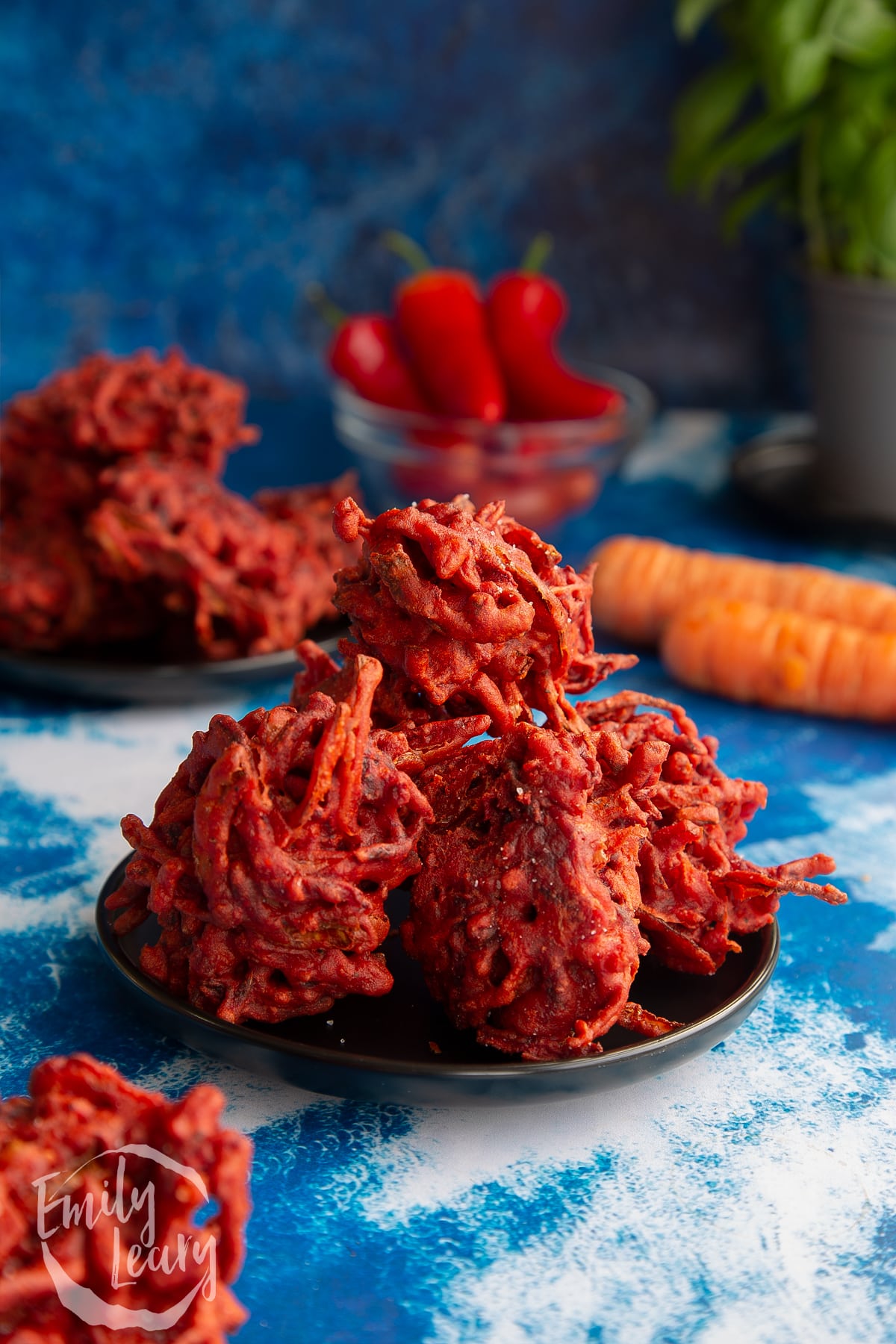
Pakoras are a traditional Indian snack recipe, usually made with a chickpea flour batter, deep fried until crisp.
Chickpea flour, also known as besan, gram flour or even garbanzo bean flour gives a distinct flavour and texture to the pakoras, making them decidedly different from, say, tempura.
Typically, pakoras are made in one of two made ways. In the first method, vegetables are cut into chunks or slices and plunged into batter to fry until crisp, as with these sweet potato pakoras. This method also works for paneer or whole boiled eggs.
The other method is shred the veggies, then combined with a slightly thicker batter, allowing spoonfuls to be lowered into the oil. This is the method used here for my beetroot pakoras.
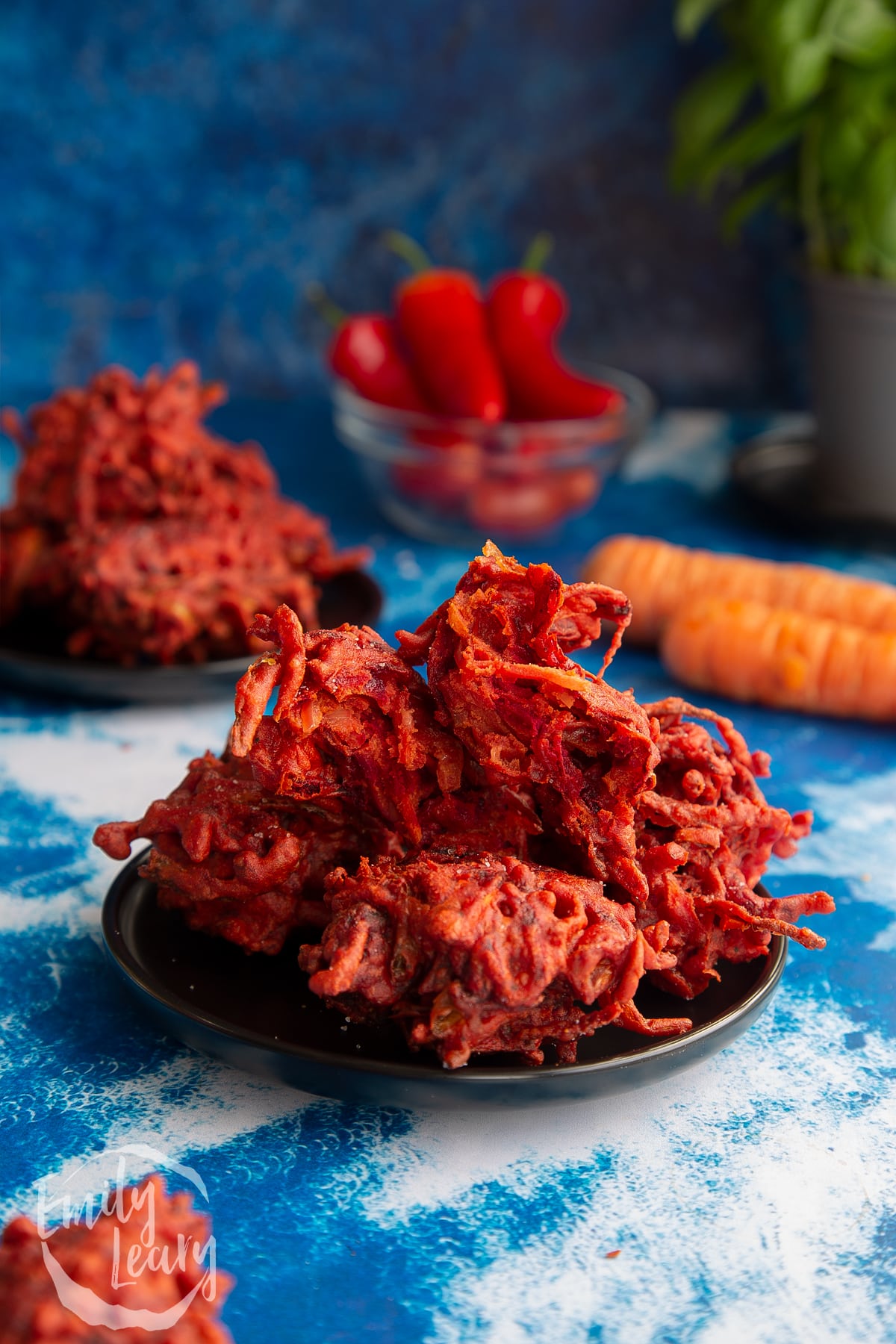
In the batter, I use gram flour, of course, and also a little rice flour to help with crispness. I flavour my batter with turmeric, chilli, coriander and cumin, but spice blends can vary according to preference and ginger is a common addition.
One you have your dry mix, you'll whisk in water to give a thick batter, then add grated beetroot, grated carrot, sliced onion and a little fresh red chilli. As soon as you stir everything together, the pigment from the beetroot will release and dye your mixture a gorgeous reddish pink.
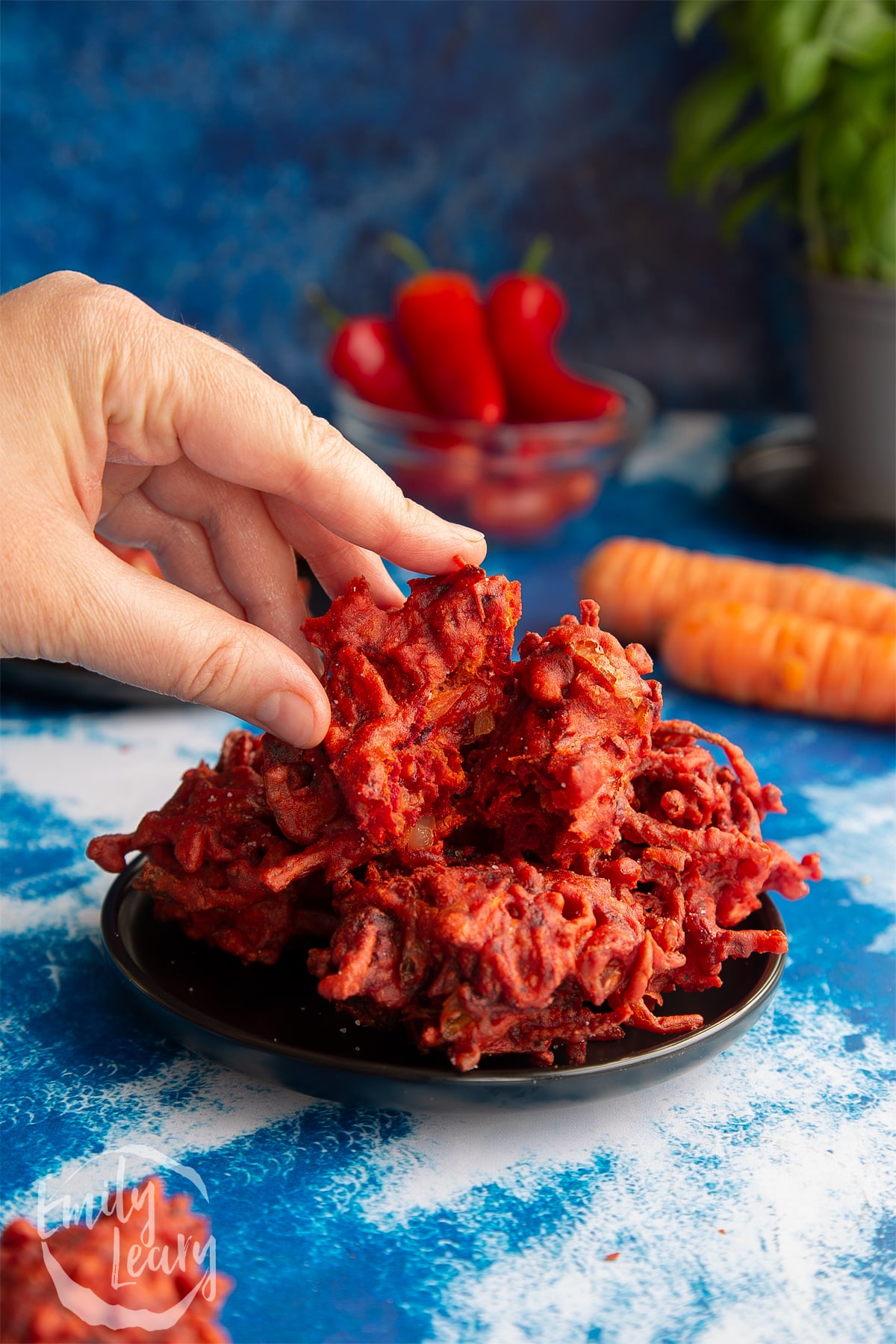
Once you fry spoonfuls of your mixture, it'll transform into deep red beetroot pakoras with crisp outers and soft and perfectly cooked inner.
Here's the full recipe for my beetroot pakoras.
Ingredients
- 125 g (4.4 oz) chickpea flour
- 25 g (0.9 oz) rice flour
- 1/2 tsp (0.5 tsp) salt
- 1/4 tsp (0.3 tsp) freshly ground black pepper
- 1/2 tsp (0.5 tsp) chili powder
- 1/4 tsp (0.3 tsp) ground coriander
- 1/2 tsp (0.5 tsp) turmeric powder
- 1/2 tsp (0.5 tsp) cumin
- 50 g (1.8 oz) carrot peeled and grated
- 125 g (4.4 oz) beetroot peeled and grated
- 1/2 brown onion halved and sliced
- 1/2 red chili finely chopped
- vegetable oil to fry
Equipment
- Deep fat fryer or suitable high-sided saucepan
Instructions
Put the chickpea flour, rice flour, salt, coriander, chilli powder, turmeric, turmeric and cumin in a large mixing bowl.
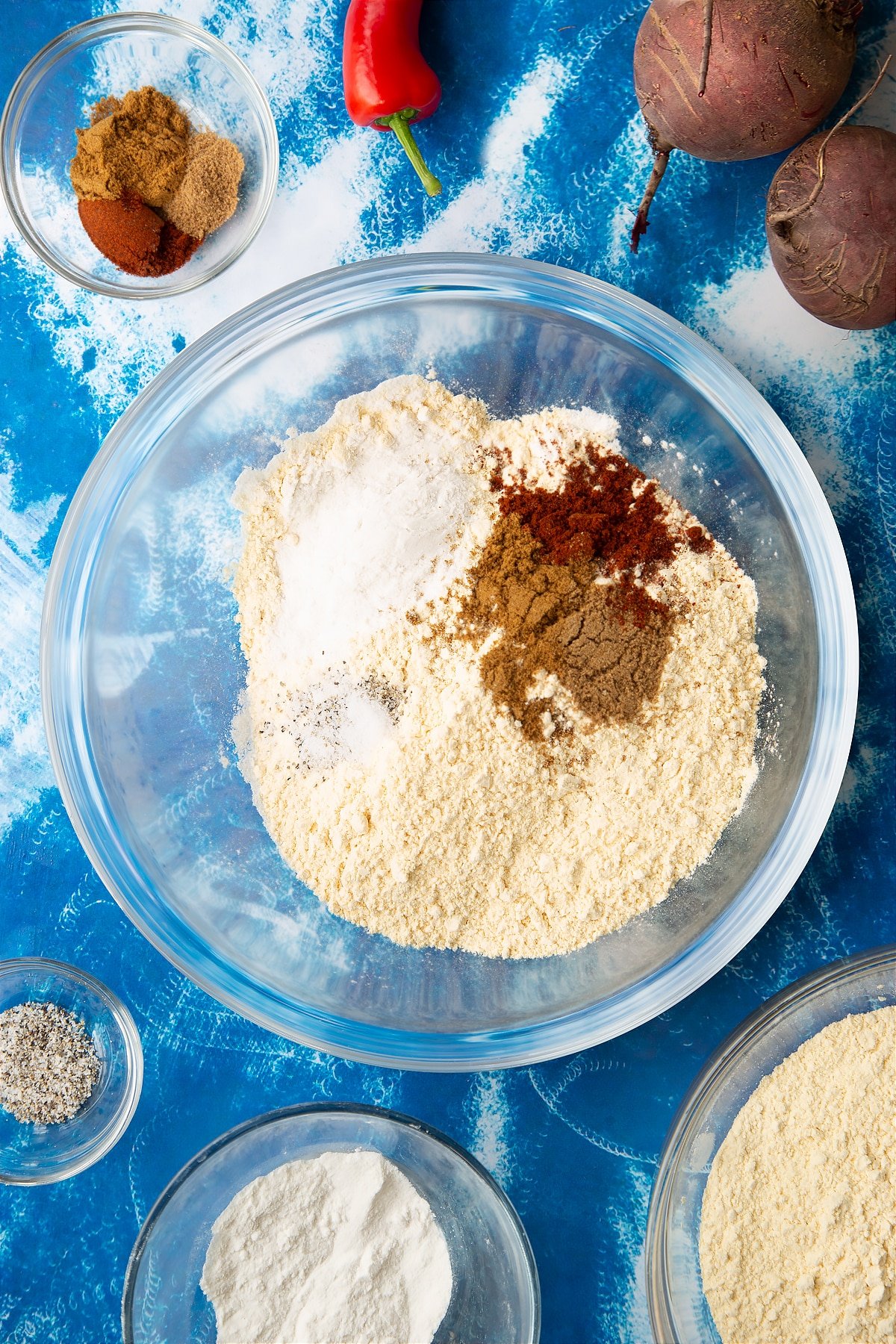
Whisk together.
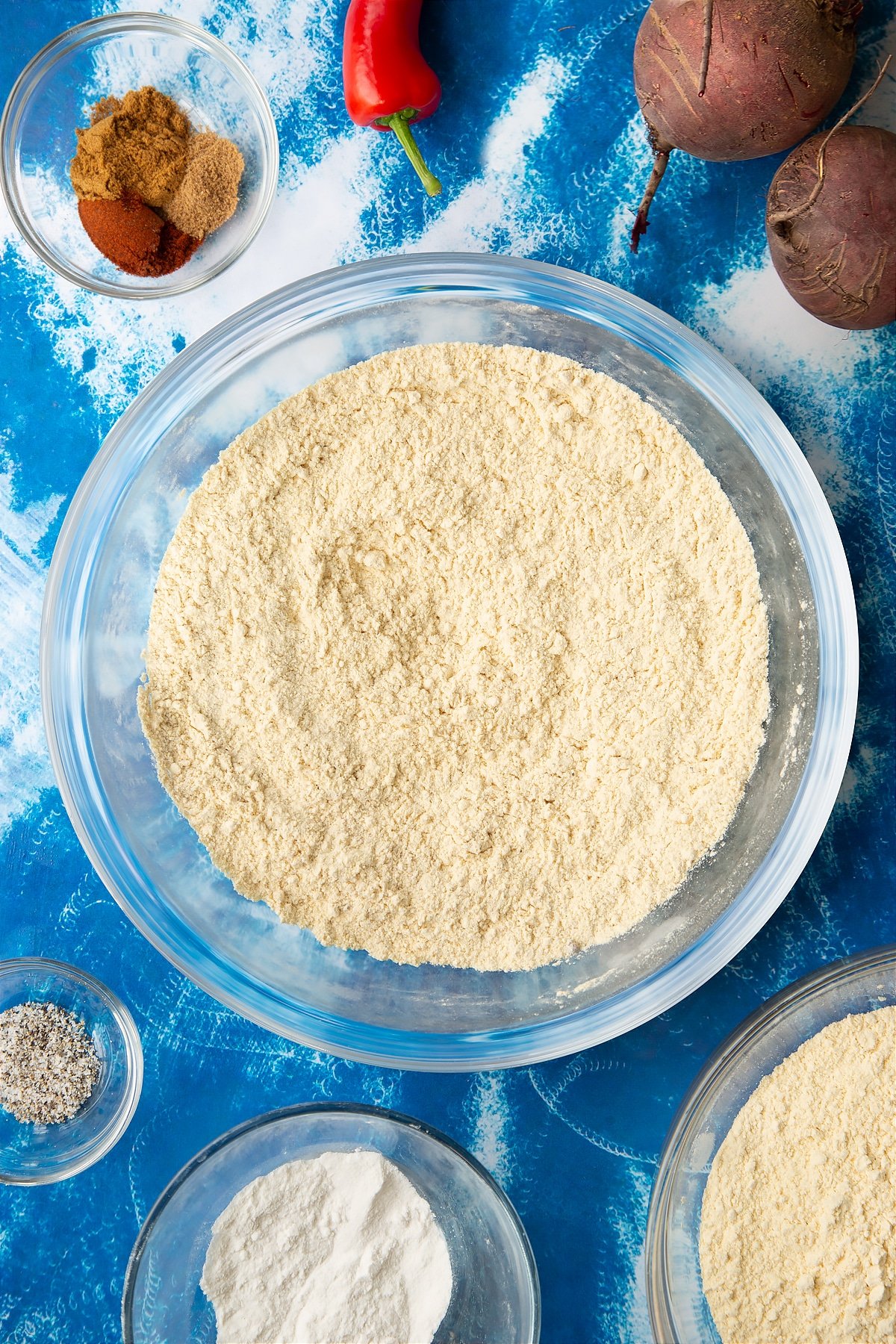
Measure 150ml (2/3 US cup) of water. Add a little at a time until you have added three quarters of the water and have a thick batter.
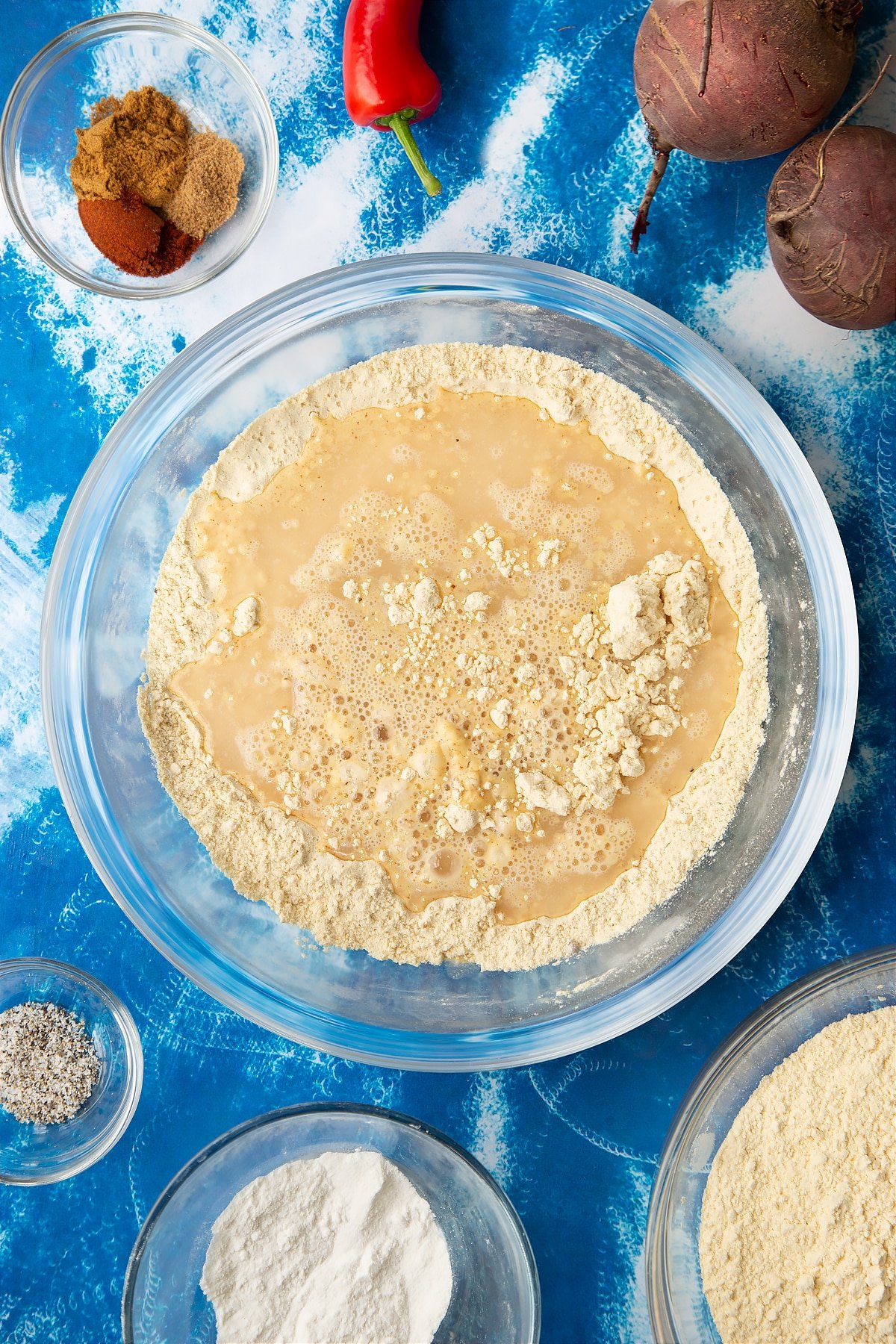
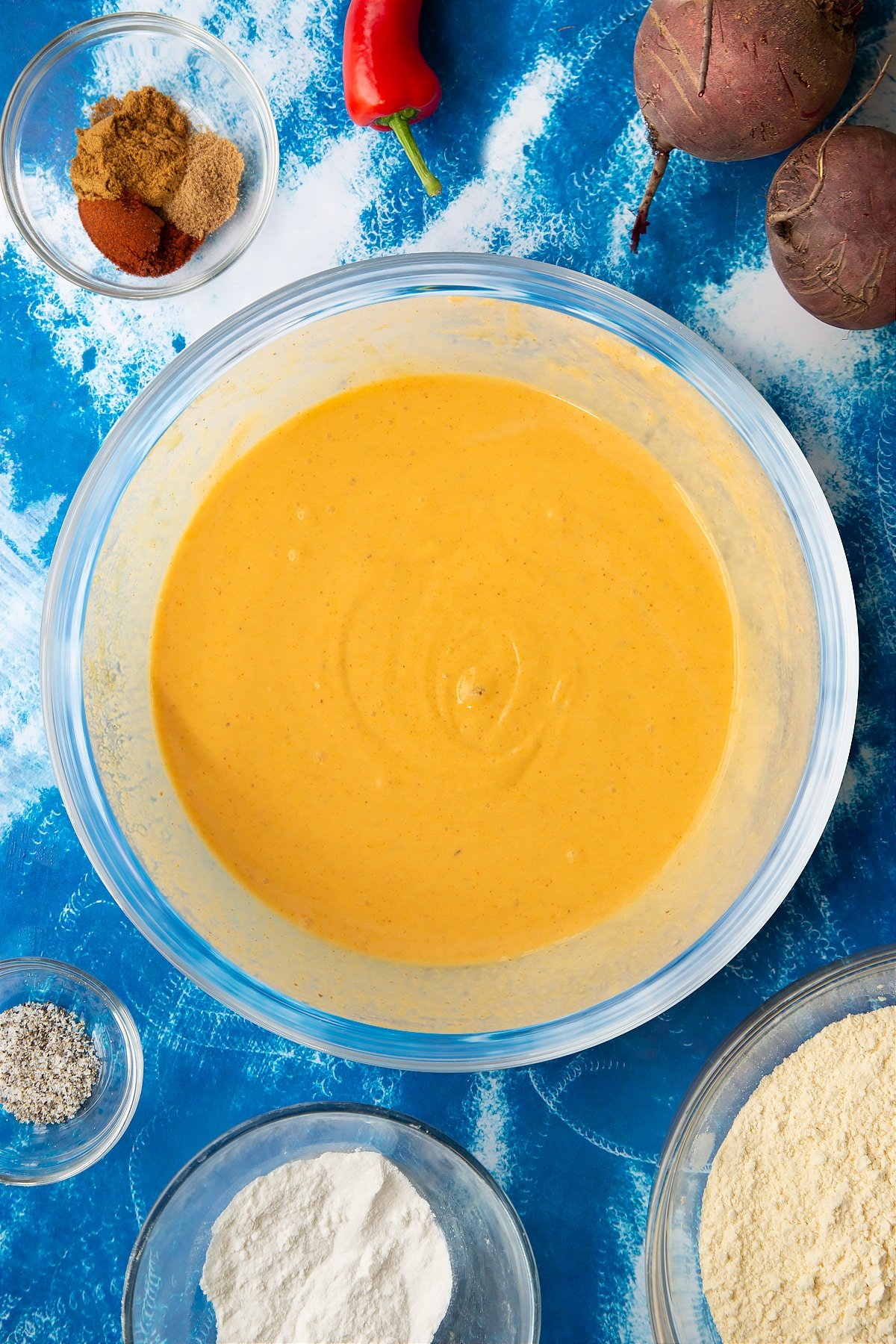
Add the carrot, beetroot, onion and fresh chilli.
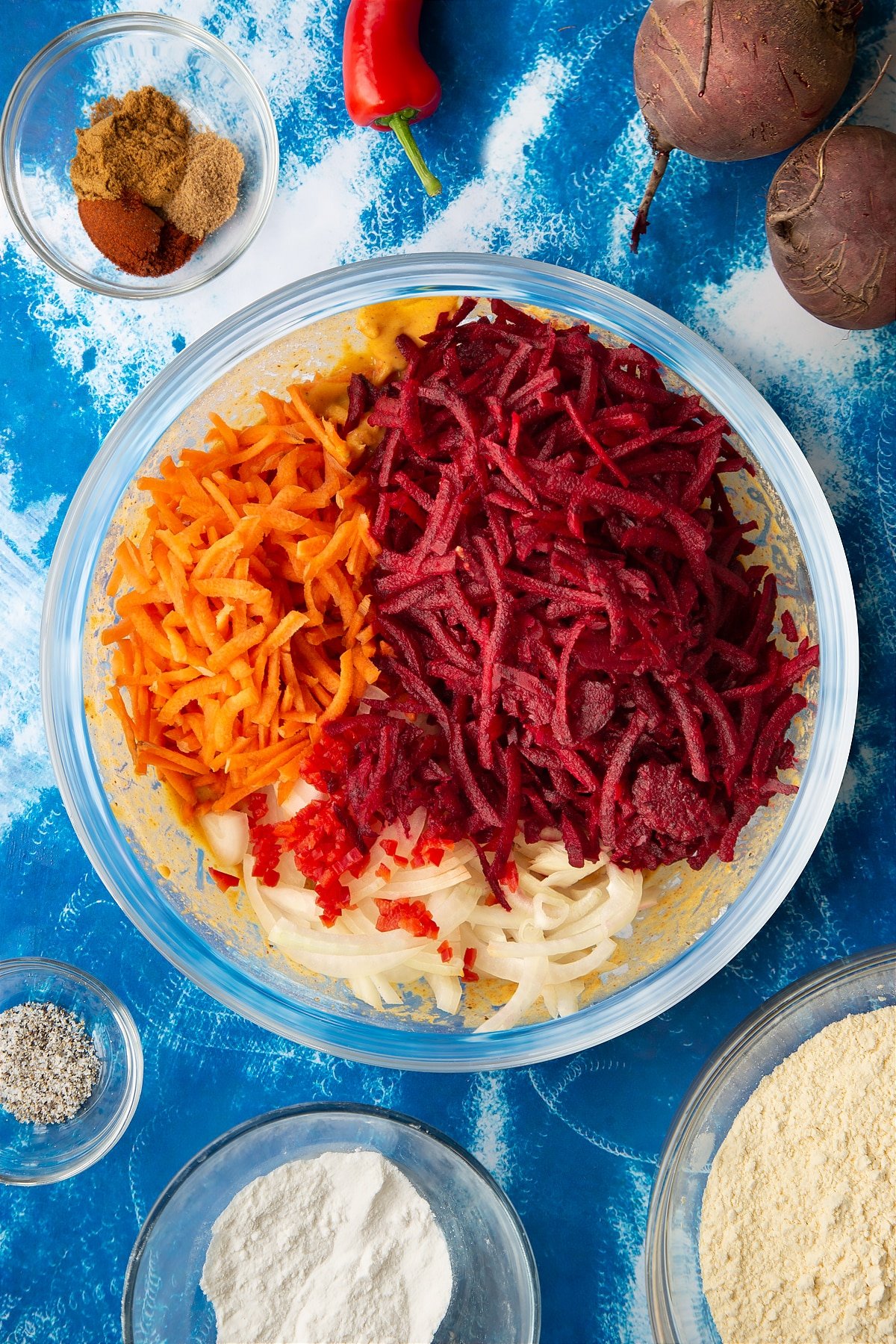
Stir well, then leave to rest for 10 minutes. The veggies will release water, so when you stir after resting, the batter will have thinned. If it seems stodgy, add a little water.
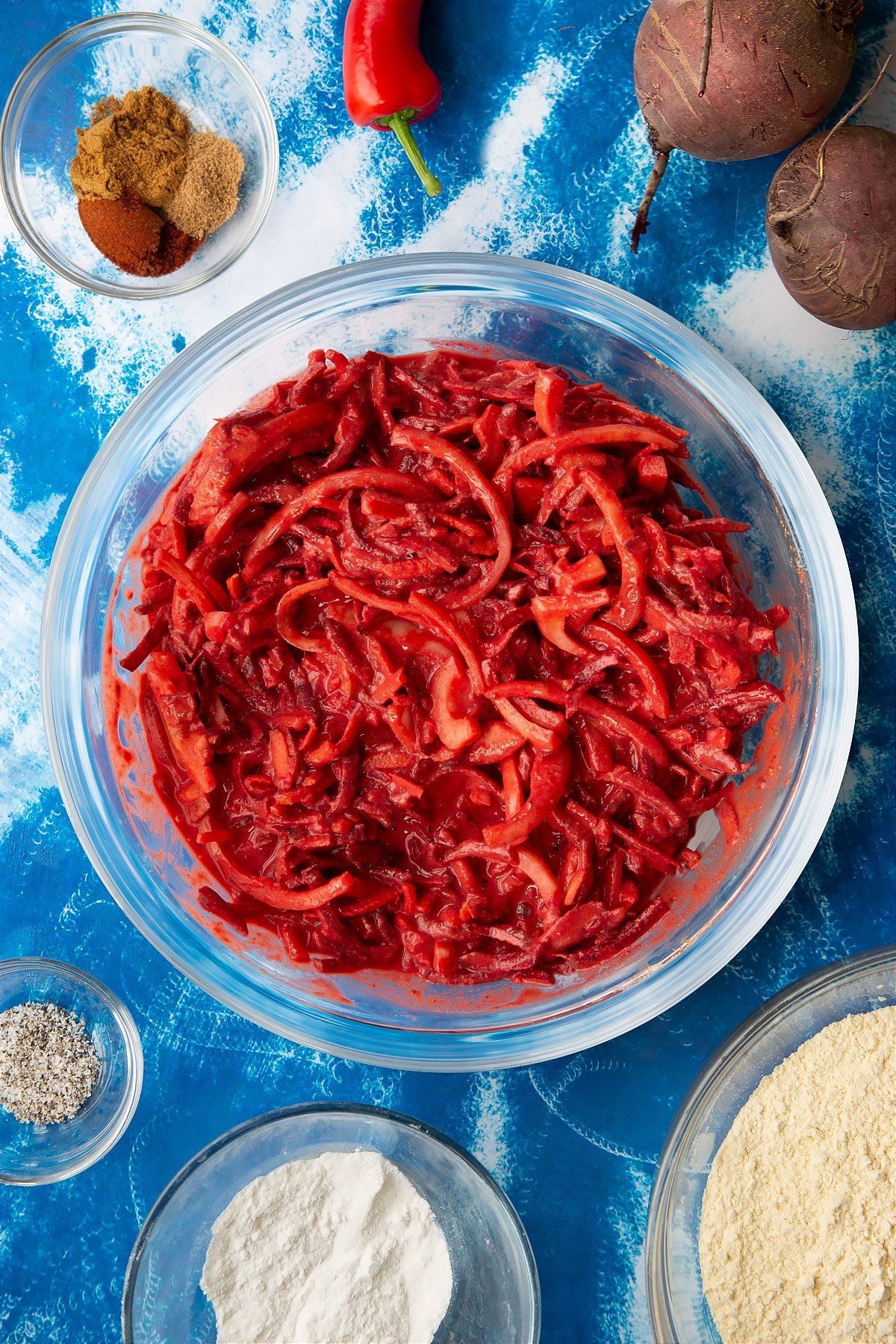
Prepare the oil in your deep fat fryer or a large, high-sided saucepan. It’s no more than one third full to allow for safe expansion during heating and cooking.
Heat the oil to 180C (355F) or until a little bit of batter dropped into the oil bubbles.
Lower large spoonfuls of batter into the oil. Only cook 3-4 pakora at a time so that you don’t overcrowd the pan.
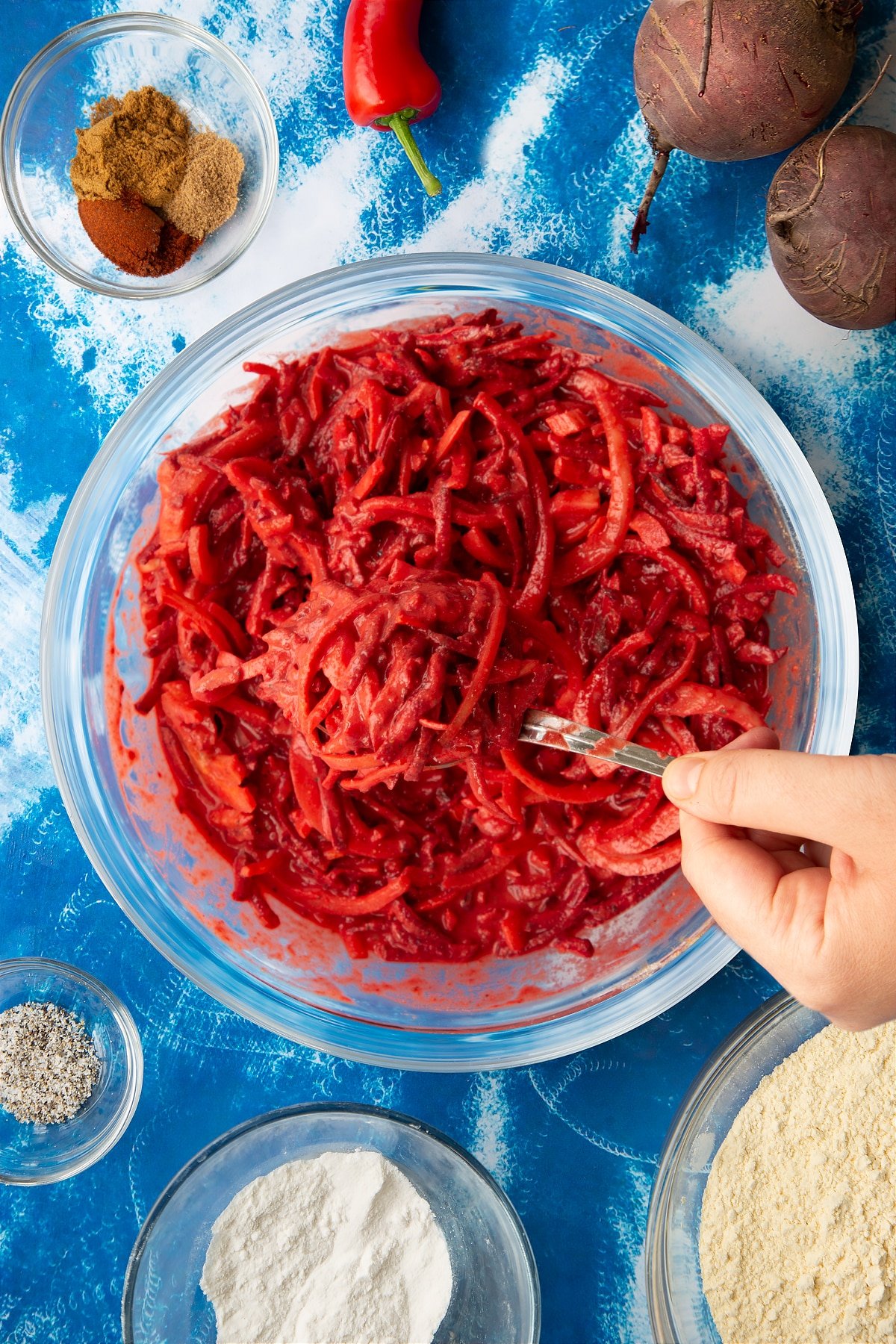
Fry for 3 minutes until crisp and golden, turning gently as needed.
Lift from the pan using a slotted spoon or straining spoon and place on a plate lined with kitchen paper to allow the oil to drain.
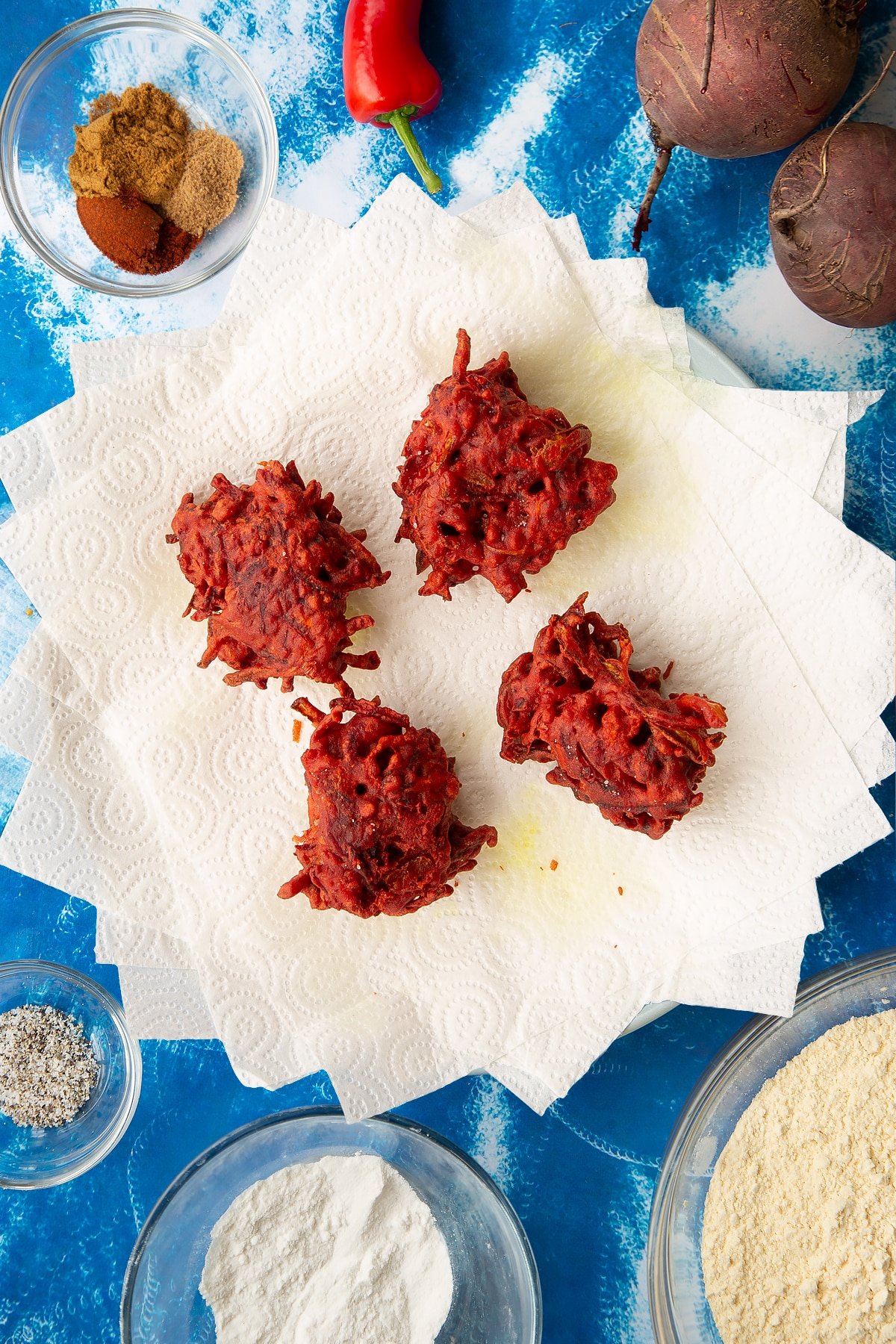
If you like, you can place the drained pakora on a baking sheet in a low oven to stay hot and crisp while you fry the rest of the batch.
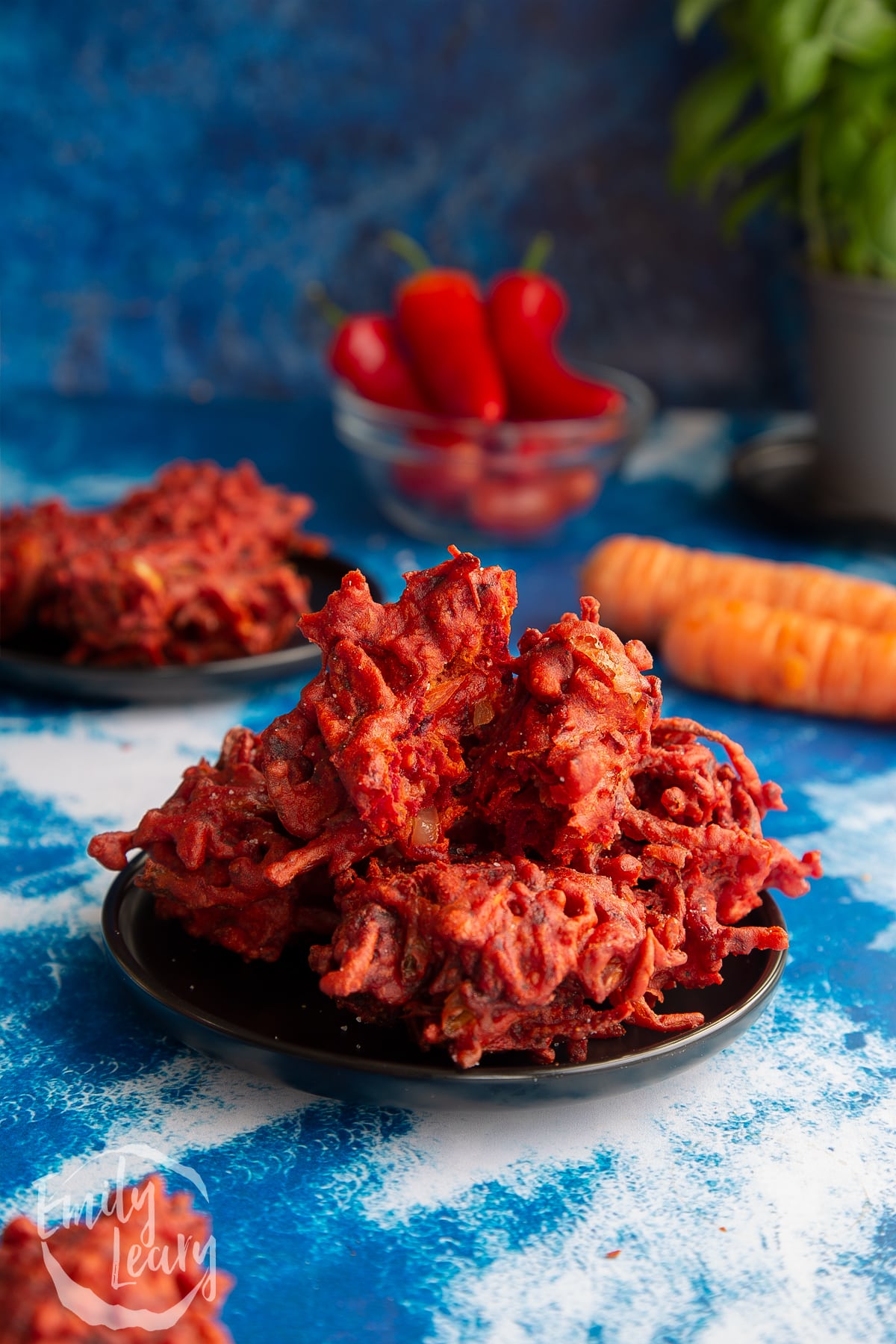
Enjoy!

Pointers, tricks and troubleshooting tips for the perfect Beetroot Pakoras
Are Beetroot Pakoras easy to make?
Beetroot pakoras are actually relatively easy to make, as long as you have all the necessary ingredients. The most difficult part is probably grating the beetroot, but it's much easier if you have a food processor or mandoline!
Once your beetroot is grated, you'll mix the dry batter ingredients with some water, toss the beetroot into the batter - then fry!
As with all of my recipes, I've included clear instructions with photos so you can see exactly how your pakoras should look every step of the way.
If you have any questions or get stuck, feel free to pop any questions in the comments below. Or you can send me a message on social media!
Remember to tag me in any photos of your pakoras - I love seeing my recipes out in the wild!
Will I need any special equipment to make Beetroot Pakoras?
You'll need a deep fat fryer or a large, high-sided saucepan to fry the pakoras. If you don't have either of these, you can use a medium-sized saucepan, but you'll need to be careful not to overcrowd the pan when frying.
I like to use a pan like this stock pot, as it's narrow enough to make oil deeper and protects from oil splashes. You can usually find stockpots in any kitchenware store or from Amazon.
There's always a complete list of suggested equipment on the recipe card below my recipes if you're in doubt.
I also always include links to example products to show exactly what I used to make each recipe.
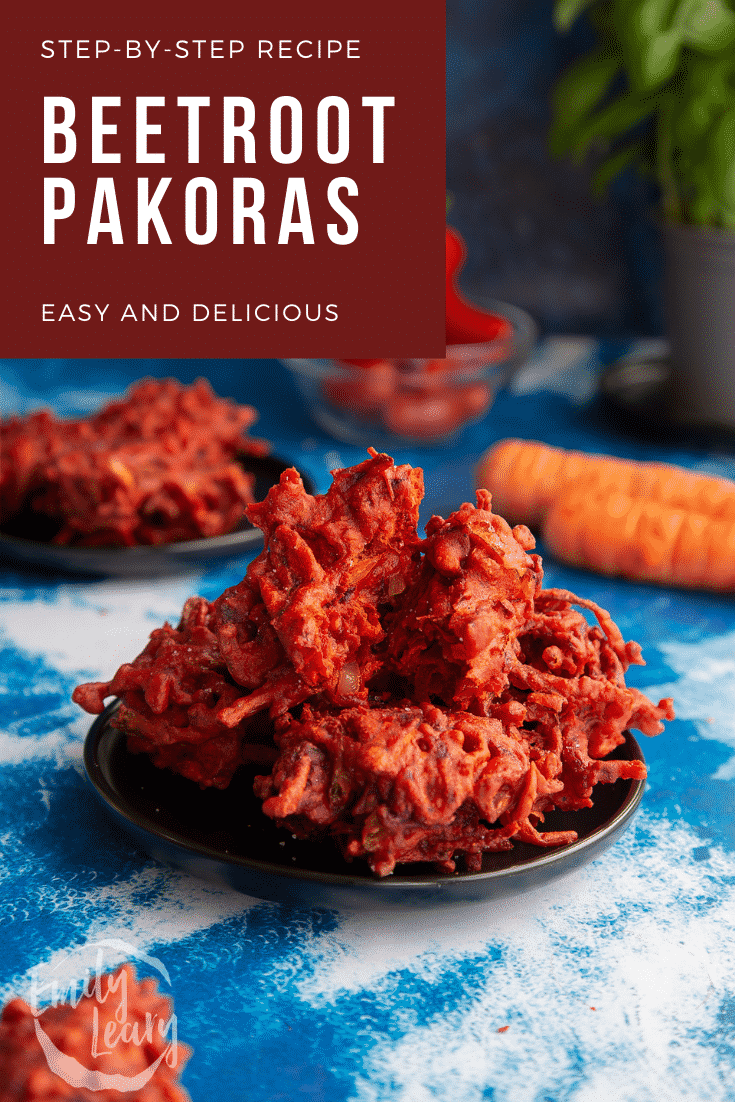
Are Beetroot Pakoras suitable for vegetarians?
Yes, Beetroot Pakoras are suitable for vegetarians!
However, if you're planning on serving this to vegetarian guests, make sure that you double-check anything extra that you intend to serve with your Beetroot Pakoras.
Manufacturers use animal-derived products to thicken, colour or flavour sweet and savoury food, so they often sneak into sauces and dips.
Are Beetroot Pakoras suitable for vegans?
Yes, Beetroot Pakoras are suitable for vegans. This recipe uses beetroot, chickpea flour and rice flour as the base, all vegan-friendly.
You'll also need to check any extra ingredients or toppings you intend to serve with your Beetroot Pakoras to ensure they are vegan-friendly.
Are Beetroot Pakoras gluten-free?
Yes, Beetroot Pakoras are gluten-free. The base of this recipe uses chickpea flour and rice flour, both gluten-free.
You'll also need to check any extra ingredients or toppings you intend to serve with your Beetroot Pakoras to ensure they are gluten-free.
Double-check all of your ingredients to make sure that they are gluten-free. Also, don't forget to check anything extra you intend to serve with your Beetroot Pakoras.
Are Beetroot Pakoras keto-friendly?
Yes, Beetroot Pakoras are keto-friendly. The base of this recipe uses chickpea flour and rice flour, both keto-friendly.
You'll also need to check any extra ingredients or toppings you intend to serve with your Beetroot Pakoras to ensure they are keto-friendly.
Are Beetroot Pakoras suitable for those on a FODMAP diet?
Yes, Beetroot Pakoras are suitable for those on a FODMAP diet. The base of this recipe uses chickpea flour and rice flour, which are both low FODMAP.
You'll also need to check any extra ingredients or toppings you intend to serve with your Beetroot Pakoras to ensure they are low FODMAP.
As always, double-check all of your ingredients labels to make sure that they are low FODMAP. Also, don't forget to check anything extra that you intend to serve with your Beetroot Pakoras.
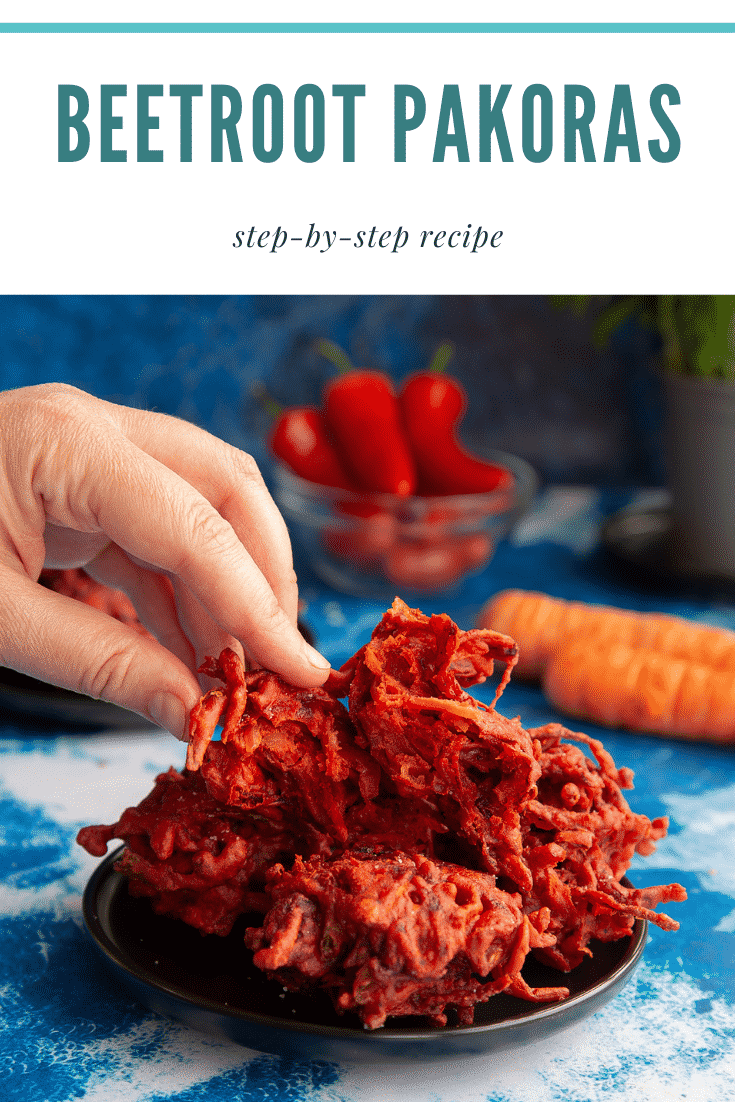
Are Beetroot Pakoras healthy?
This is a difficult question to answer as it depends on your personal definition of 'healthy'. Beetroot Pakoras are made from fresh vegetables and are fried, so they are not as healthy as roasted or steamed vegetables.
However, Beetroot Pakoras are a good source of vitamins and minerals, and they contain less fat than many other fried snacks.
To make Beetroot Pakoras healthier, you could try baking them instead of frying. I haven't tried this myself, so I can't guarantee that they will turn out the same, but it's worth a try!
Are Beetroot Pakoras safe to eat while pregnant?
Make sure that all of your ingredients are in good condition and that you prepare this meal safely and hygienically.
A Mummy Too does not offer medical advice. Please seek help from a medical professional if you need further information or have any concerns.
Are Beetroot Pakoras suitable for babies and toddlers?
No, this recipe is deep-fried and contains salt, so it isn't suitable for babies or young children.
The NHS has some fantastic resources on their website on what to feed babies and young children.
A Mummy Too does not give medical advice. If you have any questions or concerns please speak to a health professional.
How can I tell if beetroot has gone off?
Beetroot is a root vegetable, so it should be firm to the touch, with no soft patches. The leaves, if still attached, should be fresh and green with deep purple stems.
Beetroot has a rich earthy smell but shouldn't smell mouldy or sour.
If you're not sure whether your beetroot is still good to use, give it a sniff. Beetroot that has gone off will have an unpleasant rotten smell like old bins (eurgh!).
Can I use steamed beetroot for this pakora recipe?
I wouldn't recommend using steamed beetroot, as it is much softer and wetter than fresh beetroot. This could make the batter too wet and affect the texture of the pakoras.
How can I prepare beetroot without getting stains?
Beetroot can be a bit of a faff to prepare, as it can stain your hands and clothes. To avoid this, you could wear gloves while you're preparing the beetroot.
Or, according to Masterclass, you can put beetroots into a bowl of cold water and peel them underwater. Of course, if you have a big enough pot or bowl you could try grating them underwater too - but it's probably easier to use gloves!
A mandoline with a veg handle and shredding attachment is a good way to grate your beetroot cleanly. Or you could use a food processor that has a shredding option. This will be really useful for the carrots and onions too.
Just make sure to wear an apron or old clothing so you don't get splattered.
If you do get beetroot on your hands, use lemon juice to wash it off. If you get it off almost as soon as possible, you should stay stain free.
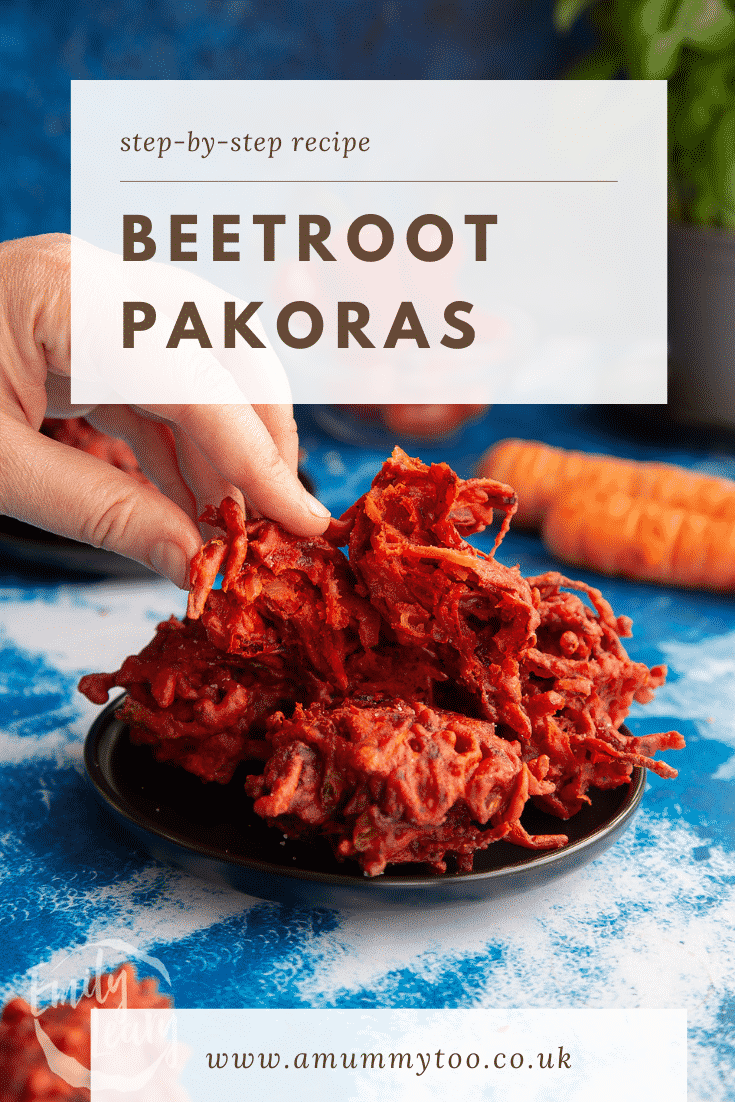
Where did you get rice flour?
You can buy rice flour from most large supermarkets. It's usually in the 'free from' section or with the other flours and baking ingredients.
If you can't find it in the store, you can buy rice flour from Amazon - which I prefer because you don't have to carry it home from the shops!
What can I use instead of gram flour?
If you can't find rice flour, you could try using another flour, such as wheat, oat or almond flour.
Chickpea flour has a very distinct texture that other flours aren't able to recreate. So bear in mind that the texture will be different if you use a different kind of flour.
Can I make my own rice flour by grinding rice?
Yes, technically, you can make your own by grinding rice in a blender or food processor.
However, you would need a high-quality power or spice blender that is able to break down the rice into small enough pieces. Otherwise, you'll just end up with rice grit.
If you try to make your own rice flour, it's important to ensure your rice is completely dry, so it doesn't become sticky.
Once your rice is ground into a powder, sieve it to remove any lumps and keep it in an airtight container for 2-3 months.
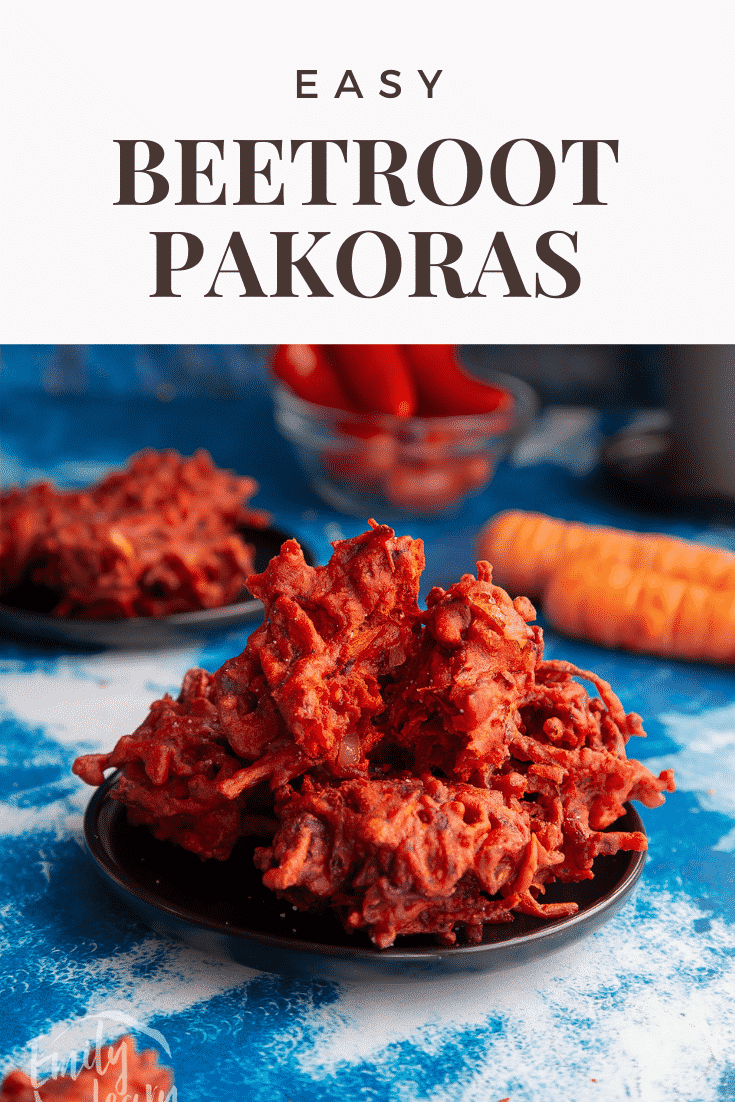
Can I make my own chickpea flour?
Yes, you can make your own chickpea flour by grinding dried chickpeas in a blender or food processor.
However, you'll need to ensure that the chickpeas are very dry before you start grinding them. Otherwise, they will turn into a paste rather than a powder - do not use canned chickpeas!
Once the chickpeas are ground into a fine powder, sieve it to remove any larger lumps.
Once your flour is processed, you can store it in an airtight container for up to two months.
What goes well with Beetroot Pakoras?
Beetroot Pakoras are often served with a dipping sauce or chutney. My personal favourite is mint yoghurt, but you could also try a tamarind chutney or a mango chutney.
Beetroot Pakoras would also be delicious and served with a salad and some raita (a yoghurt-based Indian dish).
How should I store Beetroot Pakoras?
Beetroot Pakoras are best eaten fresh, but they will keep in an airtight container in the fridge for up to 2 days.
How long will Beetroot Pakoras keep?
Beetroot Pakoras are best eaten fresh, but they will keep in an airtight container in the fridge for up to 2 days.
Can I leave Beetroot Pakoras out on the counter?
Beetroot Pakoras are best eaten fresh, but they will keep in an airtight container on the counter for up to 2 hours.
Can I make Beetroot Pakoras ahead?
Beetroot Pakoras are best eaten fresh, but you can make the batter ahead of time and store it in the fridge for up to 2 days.
Can I keep Beetroot Pakoras in the refrigerator?
Beetroot Pakoras are best eaten fresh, but they will keep in an airtight container in the fridge for up to 2 days.
Can I freeze Beetroot Pakoras?
Yes, you can freeze Beetroot Pakoras. Beetroot pakoras should freeze better than other kinds of pakora, as it has less water - so the freezing process won't too impact the texture. Beetroot Pakoras will keep in the freezer for up to 3 months.
To freeze your Beetroot Pakoras, simply layer them in between sheets of baking paper, inside a freezer-safe container. This helps protect the pakoras from freezer burn.
Freezer burn is when moisture from the food evaporates and creates ice crystals on the surface of the food. This can make the texture of the food very dry and unpleasant.
They will keep for up to 3 months. When you're ready to eat them, simply defrost at room temperature.
What is the best way to defrost Beetroot Pakoras?
Beetroot Pakoras can be defrosted at room temperature or overnight in the fridge.
If you're defrosting them at room temperature, eat them within 2 hours.
Beetroot Pakoras that have been defrosted in the fridge can be kept for up to 2 days.
What's the best way to reheat my Beetroot Pakoras?
You can either defrost or cook your pakora straight from the freezer. In fact, they may retain their shape more if you cook them frozen.
The best ways to reheat your pakora are by cooking them in the oven or frying them.
To reheat them in the oven, you could heat them for 15-20 minutes at 180C/350F.
Or, you could fry them for a minute or two until they're hot all the way through. You may need to add a little oil to the pan if they seem dry.
Can I make these Beetroot Pakoras in a different quantity?
Yes, you can easily make Beetroot Pakoras in a different quantity. Simply scale up or down the ingredients as needed.
Can I make Beetroot Pakoras in a stand mixer such as a KitchenAid or Kenwood Mixer?
Yes, you can make Beetroot Pakoras in a stand mixer. Simply add the dry batter ingredients into the bowl of your mixer and mix on low speed until combined. Then, slowly add in the wet ingredients until the batter is smooth.
Beetroot pakora batter is quite thick, so it may take a little longer to come together in the mixer than other batters.
Can I make Beetroot Pakoras with a food processor?
Yes, you can make Beetroot Pakoras with a food processor. Simply add all of the ingredients into the bowl of your food processor and blend until the batter is smooth.
How can I make sure my Beetroot Pakoras turn out perfectly?
There are a few things you can do to make sure your Beetroot Pakoras turn out perfectly:
- Use freshly grated beetroot and pat it dry with a kitchen towel. This will help reduce the chance of soggy pakoras.
- One trick for getting the moisture from onion and carrots is to shred or grate them into a bowl and mix them with a little salt. Leave them to sit for 10 minutes and the salt should draw out water. Pick fistfuls of carrot and onion up in your hands and squeeze excess liquid out over the sink, then leave it to drain on some kitchen roll. This should help your batter stay at the thickness it was when mixed.
- Make sure the oil is hot enough before you add the pakoras. If the oil isn't hot enough, the pakoras will absorb too much oil and turn out greasy.
- Cook the pakoras until they're golden brown and crispy. Don't overcook them or the beetroot will burn. Beetroot contains natural sugar so it's more prone to burning than other vegetables.
- Don't overcrowd the pan when you're frying the pakoras. This is dangerous as it can cause the oil to splutter. It also makes it more difficult to turn the pakoras so you're more likely to burn them. Plus it means some pakoras will be more submerged than others so the cooking time will be inconsistent.
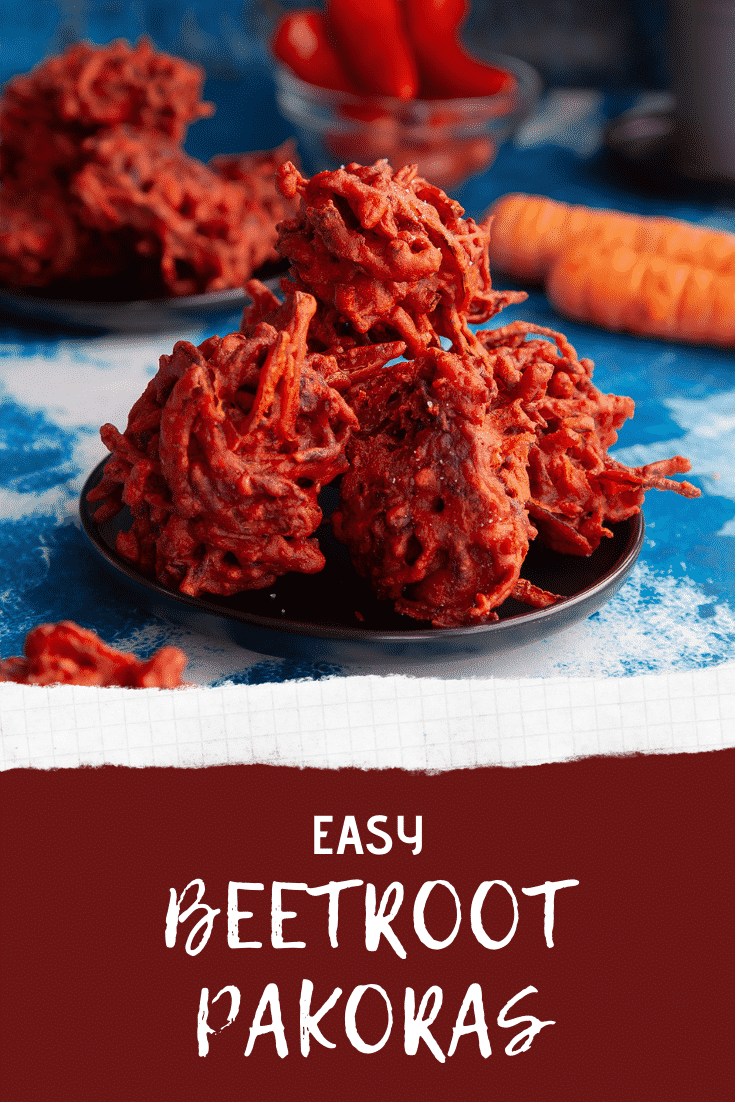
Why did my Beetroot Pakoras turn out wet/soft/dense?
There are a few reasons why Beetroot Pakoras might turn out wet/soft/dense:
- First, you may have used grated beetroot that was too wet. Squeeze out any excess moisture from the grated beetroot before adding it to the batter.
- You may have used a different flour in the batter. Gram flour produces light, puffy pakora - whereas wheat flour can be denser.
- Or you could have added your pakoras to the oil before it was hot enough. If you add pakoras to warm oil, the oil won't be hot enough to cook the coating on impact and seal it. This means the pakoras absorb more oil while it cooks, resulting in wet and greasy pakoras.
How can I add/change the flavours in these Beetroot Pakoras?
There are a few ways you can add/change the flavours in Beetroot Pakoras:
- Try adding different spices to the batter, such as cumin or garam masala.
- Try adding chopped fresh herbs, such as coriander or mint.
- Try swapping out the beetroot for another vegetable, such as sweet potato or carrot
Where is the origin of pakoras?
Pakoras are a type of fritter that are thought to originate from the Punjab region of India. They're made by coating vegetables or meat in a spiced batter and then frying them until they're crispy and golden brown.
The most popular type of pakora is made with potatoes, but there are many other variations, such as Aubergine pakoras, Bhindi (okra) pakoras and many other vegetables, cheeses and meats.
Like Onion Bhaji, Pakoras have become a popular dish in UK-Indian cuisine. You'll often see them on Indian restaurant menus, sold from street food trucks or in supermarkets.
Print this Beetroot Pakoras recipe
Beetroot Pakoras Recipe
Ingredients
- 125 g (4.4 oz) chickpea flour
- 25 g (0.9 oz) rice flour
- 1/2 tsp (0.5 tsp) salt
- 1/4 tsp (0.3 tsp) freshly ground black pepper
- 1/2 tsp (0.5 tsp) chili powder
- 1/4 tsp (0.3 tsp) ground coriander
- 1/2 tsp (0.5 tsp) turmeric powder
- 1/2 tsp (0.5 tsp) cumin
- 50 g (1.8 oz) carrot peeled and grated
- 125 g (4.4 oz) beetroot peeled and grated
- 1/2 brown onion halved and sliced
- 1/2 red chili finely chopped
- vegetable oil to fry
Equipment
- Deep fat fryer or suitable high-sided saucepan
Instructions
- Put the chickpea flour, rice flour, salt, coriander, chilli powder, turmeric and cumin in a large mixing bowl and whisk together.
- Measure 150ml (2/3 US cup) of water. Add a little at a time until you have added three quarters of the water and have a thick batter.
- Add the carrot, beetroot, onion and fresh chilli. Stir well, then leave to rest for 10 minutes. The veggies will release water, so when you stir after resting, the batter will have thinned. If it seems stodgy, add a little water.
- Prepare the oil in your deep fat fryer or a large, high-sided saucepan. It’s no more than one third full to allow for safe expansion during heating and cooking.
- Heat the oil to 180C (355F) or until a little bit of batter dropped into the oil bubbles.
- Lower large spoonfuls of batter into the oil. Only cook 3-4 pakora at a time so that you don’t overcrowd the pan.
- Fry for 3 minutes until crisp and golden, turning gently as needed.
- Lift from the pan using a slotted spoon or straining spoon and place on a plate lined with kitchen paper to allow the oil to drain.
- If you like, you can place the drained pakora on a baking sheet in a low oven to stay hot and crisp while you fry the rest of the batch.
Video
Nutrition
If you enjoyed this recipe then you'll likely also enjoy my authentic eggplant tempura recipe and my delicious zucchini tempura recipe.
Pin this Beetroot Pakoras recipe
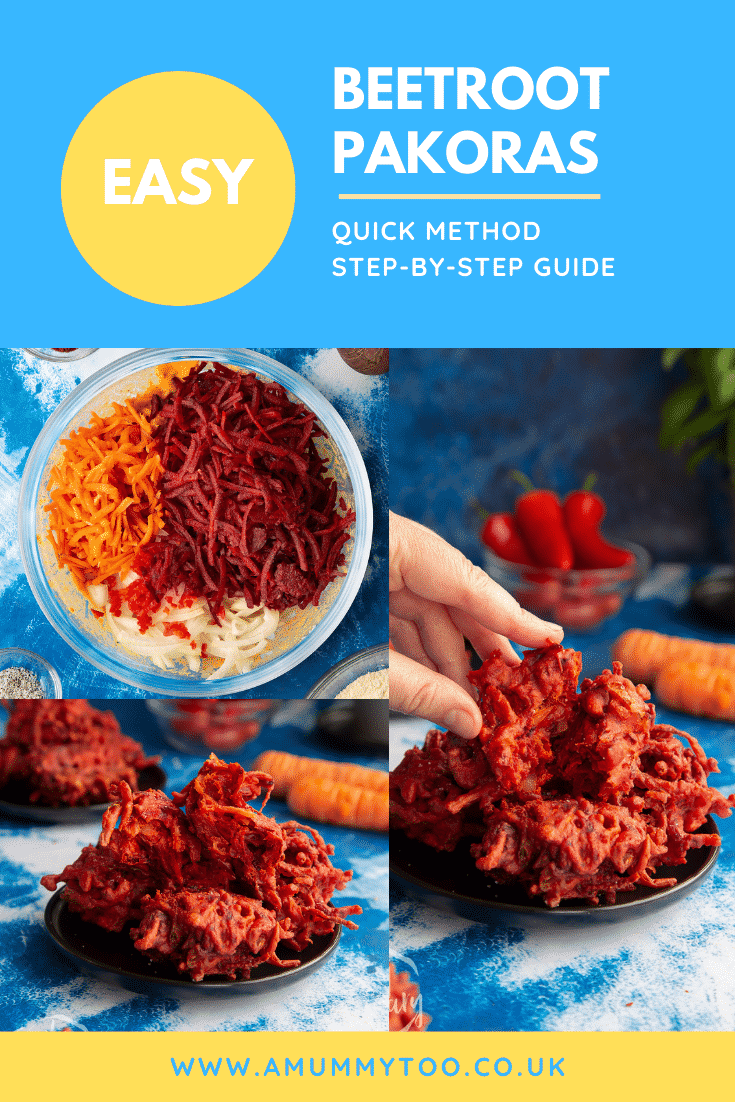
More pakora recipes to try
Have you got my book?
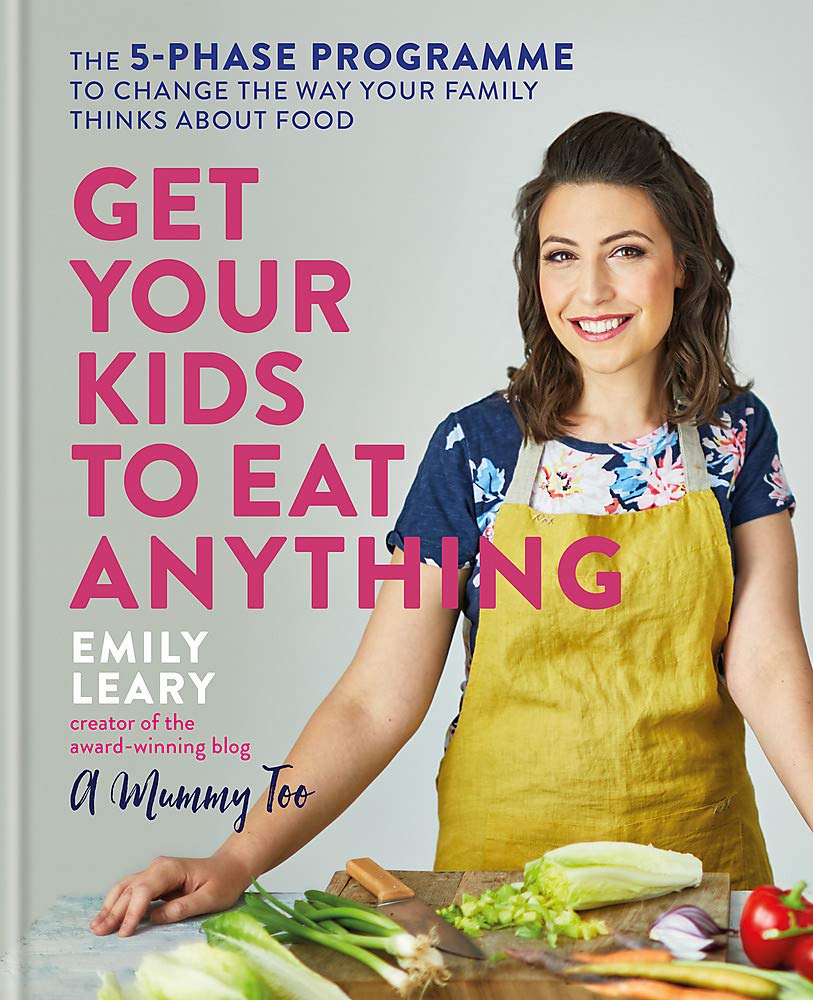
'This is a great kids cookery book. Emily is a star' - Simon Rimmer
'The book I'd like to force into any mother's kitchen' - Prue Leith
"A fab book with a plan." - Jane Devonshire, 2016 Masterchef UK winner
'Emily has managed to combine her mummy knowledge and passion for food to make a truly helpful and brilliant cookbook' - Priya Tew, RD, BSc (Hons), Msc
Get Your Kids to Eat Anything is an achievable 'how to' for parents in the battle to overcome picky eating and 'make new the norm'. Emily Leary's unique 5-phase programme looks at the issue of 'fussy eating' in a holistic way that links imagination with food, and which situates parents alongside - not in opposition to - their children.


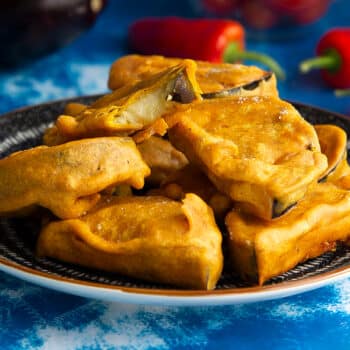
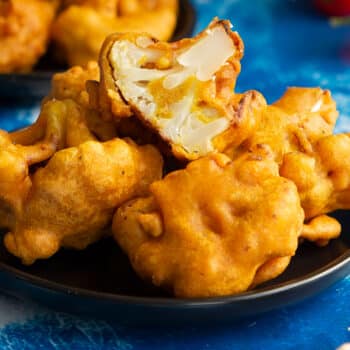
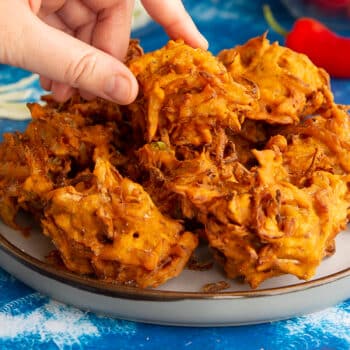
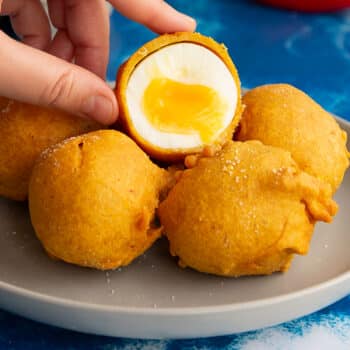
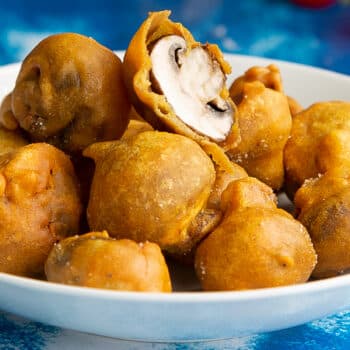
Leave a Reply